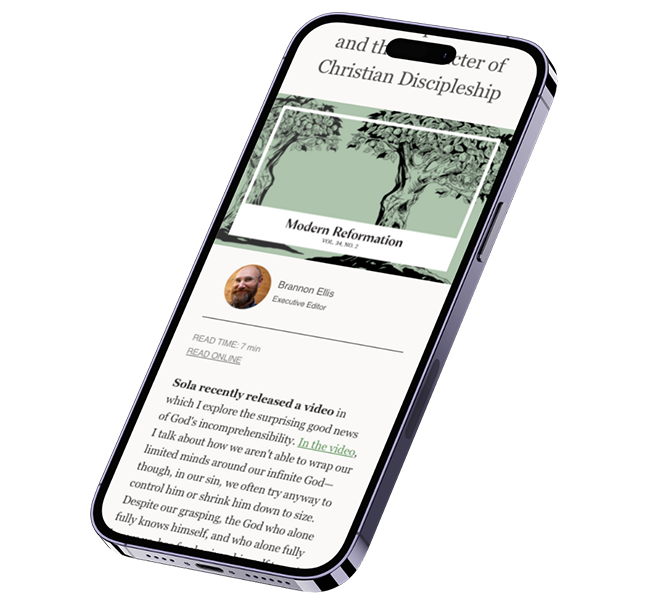Years ago, when I first began to read Lutheran theologians, I remember friends warning me to watch out. “Lutherans were weak on sanctification,” they said. But by that point it was too late. The work of Martin Luther had already begun to haunt me. The wild and paradoxical claims in his Heidelberg Disputation intrigued me; his theology of the cross moved me, and I couldn’t help but read more. It was clear to me that I encountered a deep, spiritual thinker who had a lot to say about how to live the Christian life. He was forcefully critical of antinomians: they failed to account for Pentecost and the work of the Holy Spirit. How could anyone immersed in the theology of this great German reformer fail on this point? But people did.
I remember listening to Lauren Larkin, an insightful theologian, who made the issue plain to me as she exposed the limitations and potential abuse of the model of sanctification as rest. She described a common scene in American culture: a father comes home after a hard day of work and decides to embrace his Christian liberty and rest in Christ. While enjoying his justified and adopted status before God, his wife worked in another room. She had also come home from work, but instead of rest, she had more work to do. She had to help the kids with their homework, prepare a meal, and throw a load of laundry in the machine. She too was exhausted after her own hard day in the office, but there was no rest after her labors. For this woman, sanctification looked nothing like the rest her husband experienced—while he was free to watch silly cat videos on Facebook, she was running the household. For her, sanctification was death and self-sacrifice; for him, sanctification was rest and comfort in God’s presence.
Sanctification as rest, could be abused and used to avoid the costly work of sacrifice and service. Sanctification as rest could degenerate into a practice that privileges the powerful and exploits the weak in the name of God. This is why Leopoldo Sánchez’s book, Sculptor Spirit: Models of Sanctification from Spirit Christology was such a refreshing and helpful perspective on the topic of sanctification.
Sánchez, a Lutheran theologian and professor at Concordia Seminary in St. Louis, gives readers a clear and insightful treatment of sanctification from a Lutheran perspective that is grounded in Scripture and tradition and able to account for the complexities of human life. The idea is simple: Sánchez argues that the field of “Spirit Christology, which focuses on the role of God’s Spirit in Jesus’ life and mission, serves as a constructive framework for articulating a models-based approach to sanctification” that can help students, pastors, and church leaders discern and address “some of the main spiritual concerns of various North American groups.”[1] For many, the term Spirit Christology may be new and this is in part the challenge that many readers will have with the book and he devotes an entire chapter on the field. As Sánchez understand the field, Spirit Christology is an examination of the work of the Holy Spirit in the life and mission of Jesus with a concern to examine how the work of the Spirit differs and is similar to the life of the church. And though he doesn’t explain it this way, one can say that an underlying concern in the field is understanding how Jesus, empowered by the Holy Spirit, is a model for the Christian life. This then, opens up gospel narratives of Jesus in action that provide pictures of what the sanctified life might look like for Christians seeking to be conformed to the image of Christ and live empowered by the holy Spirit. As I worked through this book, I found that Sánchez develops a fruitful project that allows him to read the Bible with fresh insight into the spiritual life, that is more broadly applicable than traditional approaches to sanctification, and is consistently orthodox.
Fresh Air Into A Biblical Doctrine
Sánchez uses the insights from Spirit Christology to construct five complimentary models of the sanctified life: the renewal model (which reveals sanctification through the themes of baptism and death and resurrection), the dramatic model (which understands sanctification as a battle against the forces of evil through prayer and resisting temptation), the sacrificial model (which pictures sanctification as sharing in Christ’s humility and sacrificing one’s self for the sake of others), the hospitality model that emphasizes welcoming strangers, and the devotional model which follows the patterns of work and rest reflected in God’s creation and recreation of the world.
Through developing his approach to Spirit Christology, Sánchez brings to life many narratives in Jesus’ life and mission, and brings light to many passages in the epistles that speak about the Spirit’s ongoing life in the church, thus showing the continuity between the work of the Spirit in Jesus’ life and mission and the work of the Spirit in the life of ordinary Christians. Showing the similarity between the work of the Spirit in Jesus’ life and ministry and the work of the Spirit in the life and ministry of the church is necessary in order to keep pastors and students from the simplistic question: what would Jesus do?
The instinct is correct, but Sánchez provides a more nuanced and complex approach that bears better fruit. Thus he says that many episodes in the life of Jesus (e.g., his temptation in the wilderness, exorcisms, his struggle in the Garden of Gethsemane) before going to the cross are “paradigmatic for adopted sons, his brothers and sisters, who mirror in their own lives his drama with the evil one.”[2] Drawing on Romans 6, he describes sanctification as “Killing the old sinful creatures and raising the new creature in the waters of baptism.”[3] He can read the pages of the Gospels and conclude that “life in the Spirit [is] a battle against the evil spirits or a struggle amid spiritual attacks.”[4] He can bring new life and imagery to the apostle Peter’s description of Christians living as exiles and sojourners in the world because he can connect it to Jesus’ own sojourn to Jerusalem and exile on the cross as he gave up his life for the sake of the world. He can reveal the Christian’s responsibility toward outcasts and foreigners as a mirror to “Yahweh’s heart for marginalized neighbors” seeing that Jesus reveals that very heart in his extending “God’s compassion to outsiders, bringing them into the kingdom,”[5] And drawing upon God’s creative work in the book of Genesis he can argue that the sanctified life embodies the rhythms of work and rest making time “for worship, for a life devoted to him [God] and our neighbor.”[6]
Broad (And Practical) Application
Noting the secularism that plagues our North American context, Sánchez adds important nuance by accounting for the struggles and experiences of Latinx communities. He explains that the rise of unaffiliated—those who, according to Pew Research Center, describe their religion as “nothing in particular”—is a mostly white phenomenon.[7] Sánchez finds that Hispanic communities to have a rich spirituality that like the global south, “shares a concern for addressing, either through advocacy or action, the plight of the poor and the socially disadvantaged.”[8] This is important since any pastor who is familiar with the literature on secularization and the rise of moralistic therapeutic deism would have a very difficult time if they assumed that spiritual condition in a majority Hispanic congregation. Sermons explaining the need for a consistent prayer life or face-to-face interactions away from technology wouldn’t quite fit the same way, and a ministry that fails to speak to the concerns of the poor, immigrants, and the socially marginalized would fail to reach the heart language of the people.
Sánchez helps the pastor apply the five models of the sanctified life by providing complimentary pictures, practices, and approaches to the Christian life that pastors, students, and church leaders can draw upon in their work of discipleship as they seek to be faithful to the particularities of their context. The value of having five distinct but complimentary models becomes obvious when thinking about how a single model can be abused, misapplied, or fail to meet the needs and struggles of a particular community. For example, in his chapter on ‘welcoming the stranger’ he explains hospitality as a life that shares itself with marginalized people. He writes,
In our reading of biblical narratives through marginal eyes, we are reminded that people are not received into God’s kingdom and family because of their language, culture, ethnicity, place of origin, or any other condition in life…This realization radically reshapes how we live the sanctified life among and interact with people who are outcasts, leading us to embrace the apostolic teaching on hospitality with new vigor. [9]
Spirit Christology’s Orthodoxy
The book’s strength also poses its greatest challenge. The fresh insights from the recent field of Spirit Christology sound novel to uninitiated ears. Many have likely never heard of Spirit Christology and others who know the field recognize that many of its proponents have taken heterodox (if not heretical) views and developed Spirit Christology as an alternative to the classic Christology most study in conservative seminaries. Because of this, Sánchez gives readers thorough research and well-founded arguments that seek to justify his unique approach to sanctification.
Throughout the book, Sánchez defends the orthodoxy of Spirit Christology, convinced that it can coexist with classic Christology. For Sánchez, Spirit Christology is not an alternative to the tradition doctrine but “a trinitarian framework” used to interpret “created life in terms of God’s action in Jesus, and through him on others, by the power of the Spirit.”[10] Spirit Christology looks at the biblical witness to “the Spirit’s role in Jesus and his saints.”[11] For him, “the same Spirit in whom Jesus lived shapes the lives of his disciples today.”[12] Thus, if traditional Christology asks questions about the person of Jesus and how his divine nature and human nature can exist in one person, Spirit Christology asks questions about the Holy Spirit’s role in the “life and mission of Jesus.”[13] Spirit Christology “asks what the identity of Jesus as the receiver, bearer, and giver of God’s Spirit contributes to our theological reflection and Christian living.”[14]
After giving an overview of four theological approaches represented by theologians G. W. H Lampe, Yves Congar, Eugene F. Rogers Jr., and Ralph Del Colle., Sánchez turns to patristic sources as he develops his own approach. Throughout the book, as he interacts with the Early Church Fathers and the work of Martin Luther, he shows that Spirit Christology isn’t a modern invention without historical precedent, but a modern development of the tradition. For Sánchez, the church fathers are theological voices that ground and inspire the work of Spirit Christology.
Conclusion
Sculptor Spirit: Models of Sanctification from Spirit Christology represents some of the best work on sanctification available to conservative, evangelical Christians who seek an understanding of sanctification that is practical, rich, and faithful to the biblical witness. This book can help many who suffer from having an anemic spiritual life and a view of sanctification that can’t account for the diversity of experiences and struggles in our churches.
Silverio Gonzalez is a producer for the Core Christianity radio program. He lives in Escondido with his wife and two children.
[1] Leopoldo Sánchez Sculptor Spirit: Models of Sanctification from Spirit Christology (Downers Grove, IL: Inner Varsity Press, 2019), 2.
[2] Sánchez Sculptor Spirit, 93.
[3] Sánchez Sculptor Spirit, 67.
[4] Sánchez Sculptor Spirit, 89.
[5] Sánchez Sculptor Spirit, 146.
[6] Sánchez Sculptor Spirit, 172.
[7] Sánchez Sculptor Spirit, 213. See also https://www.pewforum.org/2012/10/09/nones-on-the-rise-religion/
[8] 215
[9] Sánchez Sculptor Spirit, 167
[10] Sánchez Sculptor Spirit, xvi.
[11] Ibid.
[12] Sánchez Sculptor Spirit, 15
[13] Sánchez Sculptor Spirit, xvi.
[14] Sánchez Sculptor Spirit, 15.



